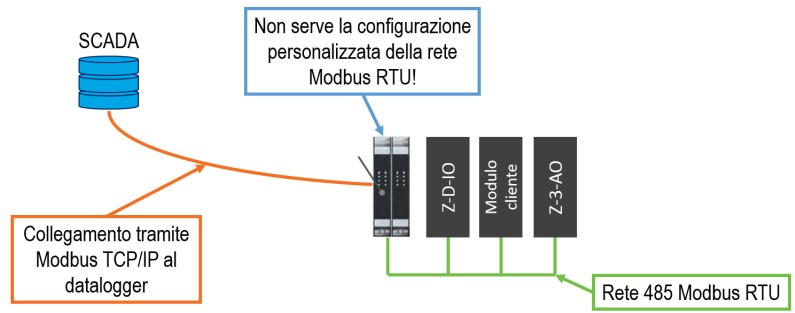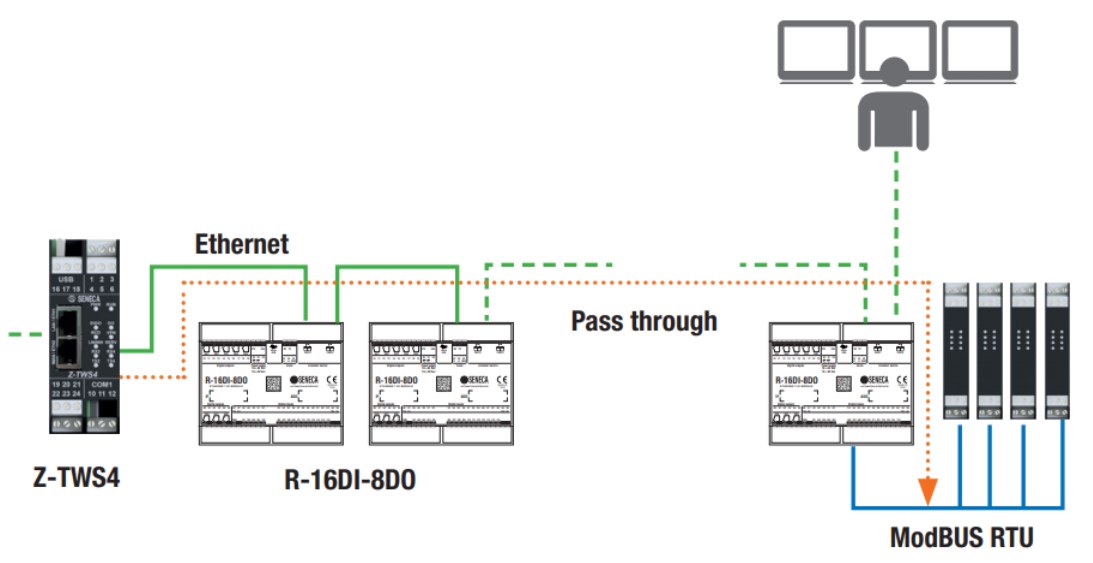 https://blog.seneca.it/wp-content/uploads/2020/05/Modbus-Pass-Through.jpg
https://blog.seneca.it/wp-content/uploads/2020/05/Modbus-Pass-Through.jpg
The advanced “ModBUS Pass-Through” function allows ModBUS devices to divert requests from Modbus TCP-IP nodes to the RS485 serial port, allowing them to perform as gateway/bridge.
The Modbus TCP-IP server integrated in these devices can act as a “Pass-Through” for the Modbus RTU for an easier management.
It is therefore a simultaneous functionality to the Gateway mode, which allows the latter to forward all requests addressed to other Modbus addresses on the serial line.
In the SENECA catalogue 8 products support this function:
- Smart datalogger: Z-LOGGER3, Z-GPRS3, Z-UMTS, Z-LTE
- Controllers/RTUs: Z-TWS4, Z-PASS2-S, S6001-RTU
- I/O Modules: R-16DI-8DO
In the case of data loggers, the integrated ModBUS TCP-IP server can perform at the same time both as a “Pass Through” for the Modbus RTU and as a ModBus protocol converter, for the benefit of easier management in the interface of SCADA systems, data collection and execution of commands. Basically data loggers can directly support the ModBUS TCP-IP Bridge function from Scada to remote I/O modules and their configuration via Z-NET4. All this without ad-hoc configuration of the ModBUS RTU network.

In the case of controllers, the Modbus Pass-through mode allows conversion from Modbus TCP-IP protocol to Modbus RTU protocol for access to devices equipped with RS485 or RS232 serial port via Ethernet (502 or 503 ports in the case of Z-TWS controllers). Another advantage offered is to allow the programming of remote I/O and nodes through Z-NET software running on a personal computer connected to a local controller via Ethernet network.

Regarding I/O modules (R-16DI-8DO) thanks to the ModBUS Pass-through function it is possible to extend the amount of I/O available through the RS485 port and the ModBUS RTU slave protocol. In this mode the RS485 port of the module stops working as ModBUS RTU slave and the device becomes a ModBUS TCP-IP ↔ ModBUS RTU gateway. Every ModBUS TCP-IP request with station address different from the I/O module one is converted in serial block on RS485 and in case of response it is redirected on TCP-IP. It is therefore no longer necessary to use additional gateways to extend the number of I/O to connect already available ModBUS RTU I/O modules.
The Ethernet port can also be used for daisy chain connection of several gateways. Basically, the Ethernet port available for “Pass-Through” modules makes their operation similar to Ethernet switches, allowing cascading connectivity to other modules with Ethernet interface.
